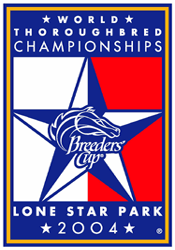|

|
 |
Lone Star Park Makes Special Preparations
for Breeders' Cup Due to VS Outbreak With a handful of cases of vesicular stomatitis (VS) diagnosed in Texas in recent months, Lone Star Park at Grand Prairie and Breeders’ Cup, Ltd. are making plans to make sure the disease does not cause a problem with the Breeders’ Cup World Thoroughbred Championships scheduled to be held at Lone Star Park on October 30, 2004. Those plans include what is being called a “disease-free zone,” that will allow horses to ship in and out of Lone Star Park. Horses at three sites in Texas and four in New Mexico are known to be infected with VS, a painful blistering disease of livestock such as horses, sheep, swine, and deer. The cases of the viral disease, which appears spontaneously and sporadically in the southwestern United States, are the first to be confirmed since 1998. Thus far, the VS cases in Texas have been located at least 400 miles away from the Dallas-Fort Worth metropolitan area, where Lone Star Park is located. The Texas Racing Commission recently tested over 1,400 horses at Lone Star Park and found them all to be disease-free. According to a report by The Blood-Horse, Breeders' Cup president D.G. Van Clief Jr. said his staff was informed on June 18 to continue the planning process for the October 30 event. He said Breeders' Cup remains in regular contact with the Texas Agriculture Commission, the United States Department of Agriculture (USDA), and the European Union (EU). Officials are working on a protocol that would be accepted by the USDA and EU. Lone Star and the surrounding area, including Dallas-Fort Worth International Airport, would be in a zone subject to surveillance. Horses would be tested, and various procedures would be implemented to ensure their health and safety. A similar plan was enacted in Colorado in 1998 to allow an equestrian event to go on as scheduled in the wake of a VS outbreak. Breeders' Cup officials received that protocol the week of June 14 and will use it as a reference. "No matter what happens through the summer, we should be able to maintain free movement of horses in and out of Lone Star Park for the Breeders' Cup," said Pam Blatz-Murff, senior vice president of Breeders' Cup operations. "Everybody is working with us. We have everybody's cooperation up and down the ladder. We feel strongly we'll get the approvals." Blatz-Murff said about one-third of the starters in the World Thoroughbred Championships usually come from outside of the U.S. "We have to be proactive," she said. "We'll have a plan in place and a facility that is secure. And there will be enough time after the event where horses can double back." The state agriculture commission has been monitoring the area around Lone Star and will determine the number of premises that contain livestock. After that study is complete, the parameters for a disease-free zone will be devised. It remains to be seen how long the VS outbreak will last. VS-infected animals and other livestock on a premises must remain quarantined until 30 days after all VS blisters or lesions heal, a process that usually takes two or three weeks. The Texas cases have occurred in the western part of the state. Blatz-Murff said a risk remains but given past patterns the disease, which is transmitted by flies, it is expected to move north out of Texas. The first VS cases of the year were confirmed May 19 in three horses at a ranch in Reeves County in western Texas. Dr. Bob Hillman, the Texas state veterinarian who heads the Texas Animal Health Commission, said the most recent cases involve three horses on a ranch in Yoakum County, about 80 miles southwest of Lubbock, and one horse in Val Verde County, about 150 miles west of San Antonio near the Rio Grande River on the Mexico border. Dr. Steve England, state veterinarian for New Mexico, said a "handful" of horses on four premises near Carlsbad, N.M., have been infected since June 4. The animals remain quarantined. Carlsbad is located about 75 miles west of the Texas border. |
| Back to News |
BENEVOLENCE | BENEFITS | GROOM ELITE | PERSONNEL | LINKS | CONTACT US
